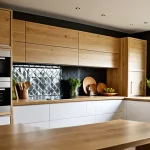Core features of UK kitchen design shaping daily routines
In UK kitchen design, a few key layout trends dominate, reflecting both tradition and modern living needs. Open-plan layouts remain exceptionally popular, seamlessly merging cooking, dining, and socialising spaces. This design fosters interaction while meal preparation is underway, making kitchens the heart of the home.
Another prevalent feature is the galley kitchen configuration. This layout is especially common in UK homes where space is at a premium. With two parallel counters, galley kitchens offer efficiency by minimising steps during cooking tasks and improving workflow. The spatial organisation of these layouts naturally guides daily routines by clearly defining zones for preparation, cooking, and cleaning.
Also to see : Achieving a stylish yet streamlined kitchen design: tips for a chic look without compromising space
Storage solutions also play a critical role in shaping kitchen usability. Integrated cabinets, deep drawers, and clever corner units maximise available space, allowing for organised storage of utensils, cookware, and pantry staples. This systematic placement reduces clutter, helping maintain a smooth meal prep flow.
Appliance positioning is carefully considered within UK kitchen design to optimise work zones. Keeping the fridge, sink, and cooker in a functional triangle facilitates intuitive movement between essential tasks. Such thoughtful appliance placement supports everyday habits by streamlining cooking processes, reducing unnecessary movement and making kitchen routines more enjoyable.
Also to discover : How embracing minimalist kitchen design can boost your health and wellness
Cultural and historical influences on UK kitchens
UK kitchens have undergone significant transformations shaped by British culinary culture and evolving sociocultural traditions. Historically, large kitchens were utilitarian spaces, separate from living areas, designed primarily for practical cooking rather than socializing. The evolution of kitchen design closely mirrors shifts in family life and cooking practices over centuries.
British eating habits have traditionally emphasized communal family meals, reflected in kitchen layouts that accommodate family gatherings around dining tables. These spaces foster a sense of togetherness, highlighting the cultural importance of shared meals in British society. This tradition has influenced the continued integration of dining spaces within or adjacent to kitchens.
In recent decades, multicultural influences have been instrumental in shaping contemporary UK kitchens. Diverse culinary traditions introduced by immigrant communities have expanded cooking styles, leading to kitchens equipped for a wider variety of cooking techniques and ingredients. This trend enhances both the functionality and cultural richness of modern UK kitchens, representing a fusion of historical British practices with global culinary innovations.
Kitchen design and its impact on healthy eating and convenience
Creating spaces that nourish both body and lifestyle
A well-thought-out kitchen layout can significantly influence healthy eating practices by shaping how easily nutritious meals are prepared. When the kitchen is organised efficiently, it reduces the effort and time needed for meal prep, directly supporting better food choices. For instance, placing fresh produce and whole grains within easy reach encourages their frequent use, while cluttered or poorly arranged kitchens often push people toward quick, less healthy options.
Modern UK homes increasingly embrace convenience in meal prep through design elements like open shelving for often-used ingredients, integrated appliances that speed up cooking tasks, and ample counter space for chopping and assembling meals. Such features help streamline the cooking process, making it simpler and more enjoyable to prepare balanced, wholesome dishes regularly. Convenience-focused design reduces the barriers to cooking from scratch and helps break the cycle of relying on processed or takeaway foods.
Experts in nutrition and home design highlight a clear link between kitchen organisation and dietary outcomes. Practical kitchen layouts encourage repeated engagement with healthy ingredients and meals, reinforcing positive habits over time. Effective designs often combine aesthetics with functionality, enabling households to sustain healthy eating without sacrificing the ease modern lifestyles demand. This balance is crucial, as kitchens that do not consider convenience risks undermining the very goal of promoting better nutrition.
Real-life examples and expert perspectives
Real-life examples from UK families illustrate how kitchen layout directly influences eating habits. For instance, some families have shifted from traditional dining tables to more informal kitchen islands, encouraging quicker, more casual meals. This change aligns with findings from behavioural insights experts who note that an open kitchen design fosters social interaction and mindful eating.
Designers emphasize that the flow and accessibility of kitchen spaces can either promote or hinder healthy eating. Nutritionists corroborate this, suggesting that kitchens designed to showcase fresh produce and prepare meals with ease motivate better food choices. For example, a family might store fruits and vegetables within easy reach, making it simpler to grab healthy snacks rather than processed options.
Notable case studies reveal that when kitchens are designed with functionality and user behaviour in mind, families tend to adopt more balanced eating patterns. Surveys conducted in the UK show a strong correlation between open-plan kitchen designs and increased family engagement during meal preparation, which often results in better dietary habits. These expert opinions and behavioural insights together underscore the pivotal role of kitchen design in shaping everyday eating practices.

